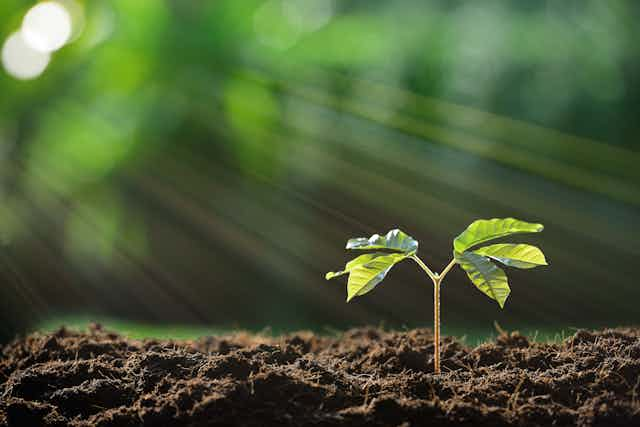As the weather warms and days lengthen, your attention may be turning to that forgotten patch of your backyard. This week we’ve asked our experts to share the science behind gardening. So grab a trowel and your green thumbs, and dig in.
Most people think of soil only in terms of the dirt that sticks stubbornly to their hands and shoes. But soil is much more than that.
A handful of soil is a small and very complex ecosystem which includes soil particles, pores, aggregates, organic matter and a staggering number of microorganisms, all of which interact to keep the soil healthy and productive.
Each soil is different. The primary factor determining the physical properties of a soil is particle size. Sandy soils have a coarse structure, large pores and little ability to hold on to water and nutrients, which makes them prone to leaching.
Clayey soils hold nutrients and water, but because the pores are small they are prone to waterlogging.
The pores between soil particles are important for water flow but also for the movement of gases. Particularly important is the exchange of oxygen with the atmosphere, because plant roots and most soil organisms need oxygen to breathe.
Sand, silt and clay particles are bound together to form aggregates. These aggregates form the skeleton, or matrix, for chemical and biological processes which are critical for soil functions.
Nitty-gritty
Organic matter and soil microorganisms play key roles in the formation and stability of aggregates.
Think of organic matter as being the glue or mortar between soil particles. But the organic matter needs be decomposed to be most effective. And this is where soil microorganisms come in.
Each gram of soil contains a billion bacteria, which is almost as much as the human population of China or India, and about 50 times the number of people in Australia.
And this number does not even include soil fungi. All these bacteria and fungi can coexist because they have different needs or don’t interact.
For example, a bacterium on one side of the aggregate is quite isolated from a bacterium on the other side of the same aggregate. So even if these two bacteria have similar needs, they don’t compete.
They may also not compete because they are not active at the same time. In a given soil condition, only a small proportion of the bacterial population is active. The majority are inactive (dormant) and come to life only when conditions are optimal for them.
Another reason for the staggering number of microbes in a gram of soil is the huge diversity. A gram of soil contains around a million different species. Among them are generalists but there are also specialists, such as those capable of fixing nitrogen from the atmosphere or degrading wood.
The food of the vast majority of soil microbes is organic matter, which is mainly plant matter. When plant matter gets into the soil, it is attacked by soil microbes for energy and nutrients.
This attack is aided by soil animals such as earthworms or mites. They mix the plant matter in the soil and its microbes, fragmenting it and thereby improving contact between plant matter and soil organisms.
During decomposition of plant matter, microbes multiply and produce carbon dioxide and nutrients for plant uptake. The dead microbes and the components of the plant matter that are very difficult to decompose help to bind the soil particles together.
This binding is also aided by slimes produced by microbes and the long filaments of fungal hyphae. The aggregates formed in this way are stable, which is important for adequate water and air supply for plant roots and soil organisms.
If aggregates are not stable, such as in sodic soils, water and air supply are restricted and plants and soil organisms will suffer.
Feeding your soil
Maintaining a certain level of organic matter in soil is critical for sustained soil health and function. Organic matter not only ensures that aggregates are stable, but also acts like a sponge, holding water, which is particularly important in sandy soils.
Another important function of organic matter is supply of nutrients required by plants. As mentioned above, decomposition of plant matter releases nutrients and it also can bind nutrients which can become available later.
But organic matter also decomposes, so needs to be replaced regularly. You can do this by adding plant matter growing in your garden or from outside to the soil, either directly or after composting.
Compost is more stable in soil than litter or straw because it is already decomposed during the composting process. It is a good glue for soil particles and binds nutrients, but it will not supply much nutrients for plants.
Fresh young plant matter is a good source of nutrients, but also decomposes very quickly and may initially release more nutrients than the plants can take up.
Mature cereal straw is nutrient-poor and decomposes slowly. So for good nutrient supply and long-term soil productivity, you may have to supply a mix of different types of organic amendments.
Of course, you can bypass this organic loop by adding inorganic fertilisers. Plants will grow well, but you have to match supply and plant demand carefully, because most fertilisers are dissolved quickly.
In your garden, you may get the best results by combining organic and inorganic fertilisation: various organic amendments for long-term soil health and stability, and inorganic fertiliser to overcome short-term nutrient deficiencies.

